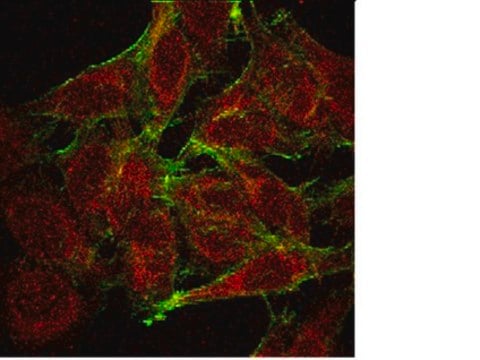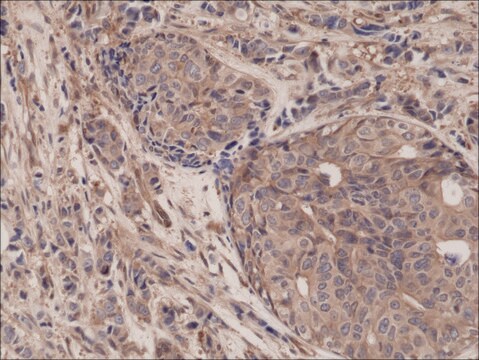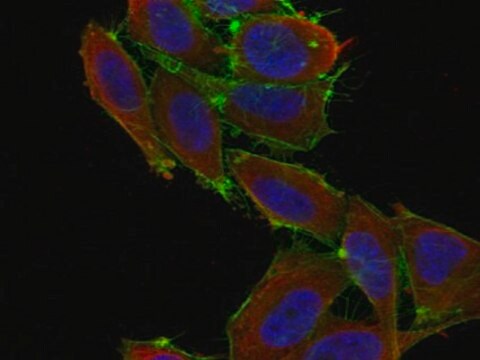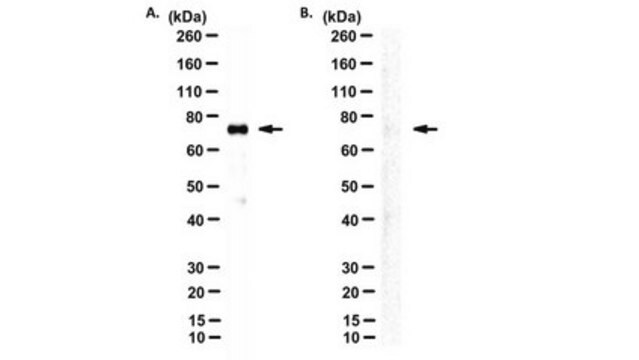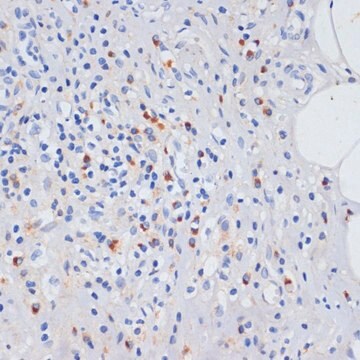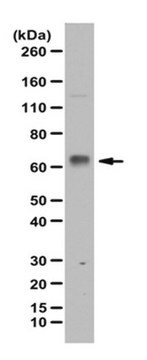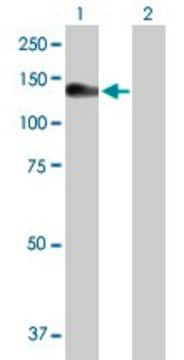MAB3026
Anti-NFκB Antibody, p65 subunit, active subunit, clone 12H11
clone 12H11, Chemicon®, from mouse
Synonim(y):
Rel A
About This Item
Polecane produkty
pochodzenie biologiczne
mouse
Poziom jakości
forma przeciwciała
purified immunoglobulin
rodzaj przeciwciała
primary antibodies
klon
12H11, monoclonal
reaktywność gatunkowa
human, rabbit, rat
reaktywność gatunkowa (przewidywana na podstawie homologii)
mouse
opakowanie
antibody small pack of 25 μg
producent / nazwa handlowa
Chemicon®
metody
electrophoretic mobility shift assay: suitable
flow cytometry: suitable
immunocytochemistry: suitable
immunofluorescence: suitable
immunohistochemistry (formalin-fixed, paraffin-embedded sections): suitable
western blot: suitable
izotyp
IgG3
numer dostępu NCBI
numer dostępu UniProt
Warunki transportu
ambient
temp. przechowywania
2-8°C
docelowa modyfikacja potranslacyjna
unmodified
informacje o genach
human ... NFKB1(4790)
Powiązane kategorie
Opis ogólny
Specyficzność
Immunogen
Zastosowanie
A 1-10 μg/mL concentration of a previous lot was used in immunofluorescence.
Immunohistochemistry (paraffin sections):
A 5-10 μg/mL (APAAP) concentration of a previous lot was used in immunohistochemistry.
Immunohistochemistry (frozen sections):
A 5-10 μg/mL (APAAP) concentration of a previous lot was used in immunohistochemistry.
Immunohistochemistry:
The clone 12H11 works best in fresh frozen or acetone fixed human tissues, however some groups have had reactivity in traditional formalin fixed tissue when the tissue is of human origin. It is recommended that ABC or enhanced detection systems be employed for the best visualization in either acetone or formalin fixed tissues. The antibody reacts with human tissues best. Rat tissue will also react but at a lower affinity, and the antibody does not react with mouse, other species have not been examined. Microwave citric acid buffer or trypsin digestion antigen recovery have both been successful with 12H11 on formalin fixed tissues.
Western blot: 5-10 µg/mL (ECL)
Electrophoretic Mobility Supershift Assay:
A 0.5-1 μg/mL concentration of a previous lot was used in Supershift assay.
Flow cytometry:
A previous lot of this antibody was used in flow cytometry. Fixed cells only, acetone fixed cells.
Optimal working dilutions must be determined by end user.
Epigenetics & Nuclear Function
Transcription Factors
Jakość
Western blot:
1:500 dilution of this lot detected NF KAPPA B, P65 on 10 μg of PC12 lysates.
Opis wartości docelowych
Postać fizyczna
Przechowywanie i stabilność
Aliquot to avoid repeated freezing and thawing. For maximum recovery of product, centrifuge the original vial after thawing and prior to removing the cap.
Komentarz do analizy
TNF α-treated HeLa cells, PMA and calcium ionophore-treated Jurkat cells.
Inne uwagi
Informacje prawne
Oświadczenie o zrzeczeniu się odpowiedzialności
Not finding the right product?
Try our Narzędzie selektora produktów.
polecane
Certyfikaty analizy (CoA)
Poszukaj Certyfikaty analizy (CoA), wpisując numer partii/serii produktów. Numery serii i partii można znaleźć na etykiecie produktu po słowach „seria” lub „partia”.
Masz już ten produkt?
Dokumenty związane z niedawno zakupionymi produktami zostały zamieszczone w Bibliotece dokumentów.
Klienci oglądali również te produkty
Nasz zespół naukowców ma doświadczenie we wszystkich obszarach badań, w tym w naukach przyrodniczych, materiałoznawstwie, syntezie chemicznej, chromatografii, analityce i wielu innych dziedzinach.
Skontaktuj się z zespołem ds. pomocy technicznej